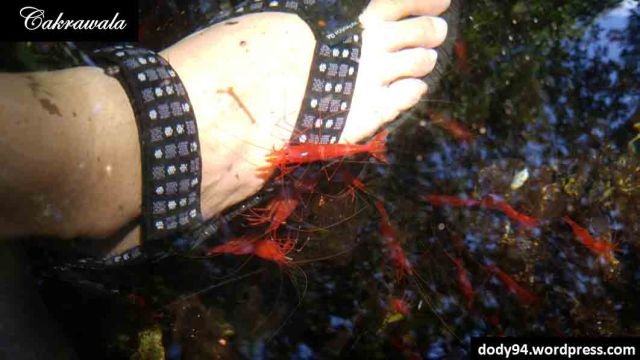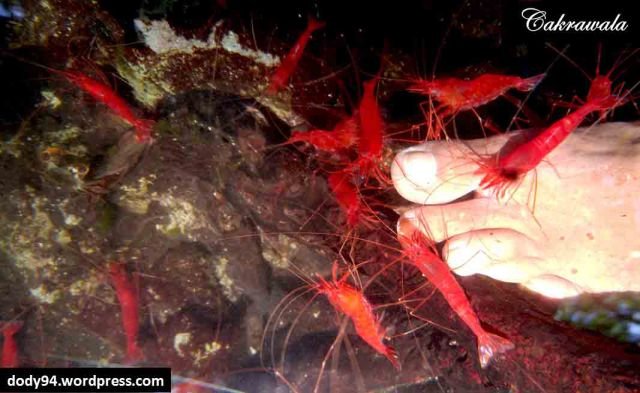Red Shrimp Beach Koguna

Buton is the largest island in the southeast peninsula of Sulawesi. Landscape dominated by limestone hills and lush tropical forests. Stretching from north to south, the island of Buton has a long coastline. Type of beach found in Buton very varied. Starting from the white sandy beaches are shallow, muddy, rocky coast to coast steep cliffs. One of the typical white sandy beaches on the island is the beach Koguna.
Koguna beach located in the village Mopaano, District of South Lasalimu Buton. The layout of the beach is very strategic because it is close to Wangi-Wangi which became the capital of Wakatobi. From the beach Koguna, Wakatobi can be reached by boat within an hour.
Not far from the shoreline toward the inside of the forest, there is a brackish water lake measuring 70 x 25 m. The banks of the lake is composed of chunks of rocks with holes sharp. On the sidelines of this rock boulder, growing mangroves of the Red Tanjang types Bruguiera gymnorrhiza whose roots rock solid grip. From the size of a large trunk, it can be seen that the mangrove trees that grow in the lake's old age.

This small lake is home to thousands of small-sized shrimp. Her whole body was red like a chili. The shrimp was first discovered by local residents around 1971. Interestingly red shrimp on the beach Koguna is pretty tame and not afraid of human presence. In fact, if we put feet into the water, this shrimp would come over and pinch your feet with a pair of pincers.
It felt quite painful, but not as painful red ant bites. He might look benign, red shrimp are able to move quickly so elusive. In addition to the red shrimp, in a small lake shore, Koguna also found several types of snails and crabs. According to local belief, the red shrimp on the beach, Koguna a sacred shrimp originating from Buton Sultanate condemned soldiers. The shrimp is also believed to bring misfortune to those who eat them or take them.

This behavior is similar to the red shrimp cleaner shrimp that live in the sea. Cleaner shrimp in the sea usually are omnivores that eat animals and plants. The shrimp eat the remaining parts of plants and animals that have died. Therefore, cleaner shrimp are often classified into scavengers.

Red shrimp pond was once possible is by the sea or have a relationship with the sea before it was interrupted by sand deposits which are then covered with coastal forest. But the lake water salty or brackish indicative of the influence of the sea on this lake. On the bottom or side of the pool, there may be a channel or a small tunnel connecting this lake with the sea.
Cleaner shrimp that live in the sea, has a unique behavior. The shrimp will usually gather at a specific location in the coral-called "cleaning stations". Large fish such as grouper and turtle usually will stop pauses in the cleaning station.

Parasites and dead cells contained in the skin or in the mouth turtle grouper will be cleaned by a cleaner shrimp using a pair of pincers. One type of cleaner shrimp in the sea bright red and the best known is Lysmata amboinensis.
Interacting with red shrimp is a memorable experience. It was, we do not want to hurry home. We feel different sensations when walking the red shrimp creep and crawl over and between the toes.
Shrimp tentacles long and the movement of the legs of shrimp creeping on the skin tingling leg raises. The climax occurs when a pair of tweezers is pinching leg shrimp to take the dead skin cells. A mixture of amusement and pain make eyelids blinked.
For red shrimp fishing to gather in large numbers, visitors need to bait use biscuit crumbs or bread sprinkled into the lake. Every time I throw a small piece of bread, about 40-50 red shrimps will gather at the feet.

The existence of such red shrimp in the lake Koguna Beach is a natural phenomenon that is rarely found in other places that need to be preserved. Not yet known what caused the striking red color on this red shrimp. The species name or scientific name of this shrimp was we do not know yet. However, this beautiful shrimp potential for breeding and used as ornamental shrimp in the aquarium.
Happy follow @urayirvan, sharing and voting steemit community.... :)